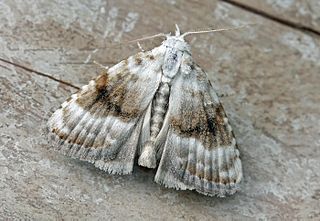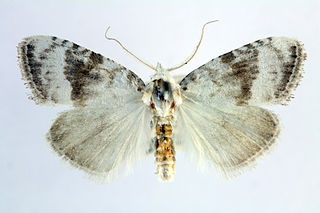
Nolidae is a family of moths with about 1,700 described species worldwide. They are mostly small with dull coloration, the main distinguishing feature being a silk cocoon with a vertical exit slit. The group is sometimes known as tuft moths, after the tufts of raised scales on the forewings of two subfamilies, Nolinae and Collomeninae. The larvae also tend to have muted colors and tufts of short hairs.

Cranmore is a village on the Isle of Wight. It is located about three miles east of Yarmouth, in the northwest of the island. It is in the civil parish of Shalfleet.

Meganola albula, the Kent black arches, is a moth of the family Nolidae. The species was first described by Michael Denis and Ignaz Schiffermüller in 1775. It is found in the Palearctic realm.

Meganola is a genus of moths of the family Nolidae. The genus was erected by Harrison Gray Dyar Jr. in 1898. It is sometimes considered a synonym of Roeselia.

Meganola strigula, the small black arches, is a moth of the family Nolidae. The species was first described by Michael Denis and Ignaz Schiffermüller in 1775. It is found in Europe, Russia and Asia Minor.
Meganola brunellus is a moth of the family Nolidae. It is found in Sri Lanka, India, Taiwan, Japan, the Ryukyu Islands, Sundaland, Queensland and the Bismarck Islands. It is an introduced species in Hawaii.

Manoba major is a moth in the family Nolidae. It was described by George Hampson in 1891. It is found in India, Taiwan, Japan, Myanmar, Singapore, as well as on Borneo, Java, Vanuatu and New Caledonia. Its habitat is coastal areas near mangroves.

Meganola phylla, the coastal plain meganola moth, is a moth of the family Nolidae. It is found in North America, where it has been recorded from Alabama, Florida, Georgia, Illinois, Indiana, Maine, Maryland, Mississippi, New Jersey, North Carolina, Ohio, Oklahoma, Ontario, South Carolina, Tennessee, Virginia and West Virginia.
Meganola hypenoides is a species of moth of the family Nolidae. It occurs on São Tomé Island, an island off the western equatorial coast of Central Africa. The species was described by George Talbot in 1929 as Nola hypenoides based on specimens collected in 1925 by T.A. Barns. In 2012, it was placed in the genus Meganola.
Meganola varia is a species of moth in the family Nolidae and superfamily Noctuoidea. The species was first described by William Barnes and Arthur Ward Lindsey in 1921. It is found naturally in North America, where it has been recorded throughout Arizona, New Mexico, and western Texas. While some moths of its species have reportedly been photographed in California, Meganola varia is not found on the California Moth Checklist.
Meganola minor is a species of nolid moth in the family Nolidae. It is found in North America.
Meganola fuscula is a species of nolid moth in the family Nolidae. It is found in North America.

Meganola spodia, commonly known as the ashy meganola or Franclemont's meganola moth, is a species of nolid moth in the family Nolidae. It is found in North America.

Meganola minuscula, the confused meganola, is a nolid moth. The species was first described by Philipp Christoph Zeller in 1872. It is found in North America.
Meganola dentata, the toothed meganola moth, is a species of nolid moth in the family Nolidae. It is found in North America.
Meganola conspicua, the conspicuous meganola moth, is a species of nolid moth in the family Nolidae. It is found in North America.









